tow Oldsmobile Bravada 2003 Owner's Manuals
[x] Cancel search | Manufacturer: OLDSMOBILE, Model Year: 2003, Model line: Bravada, Model: Oldsmobile Bravada 2003Pages: 410, PDF Size: 20.1 MB
Page 35 of 410
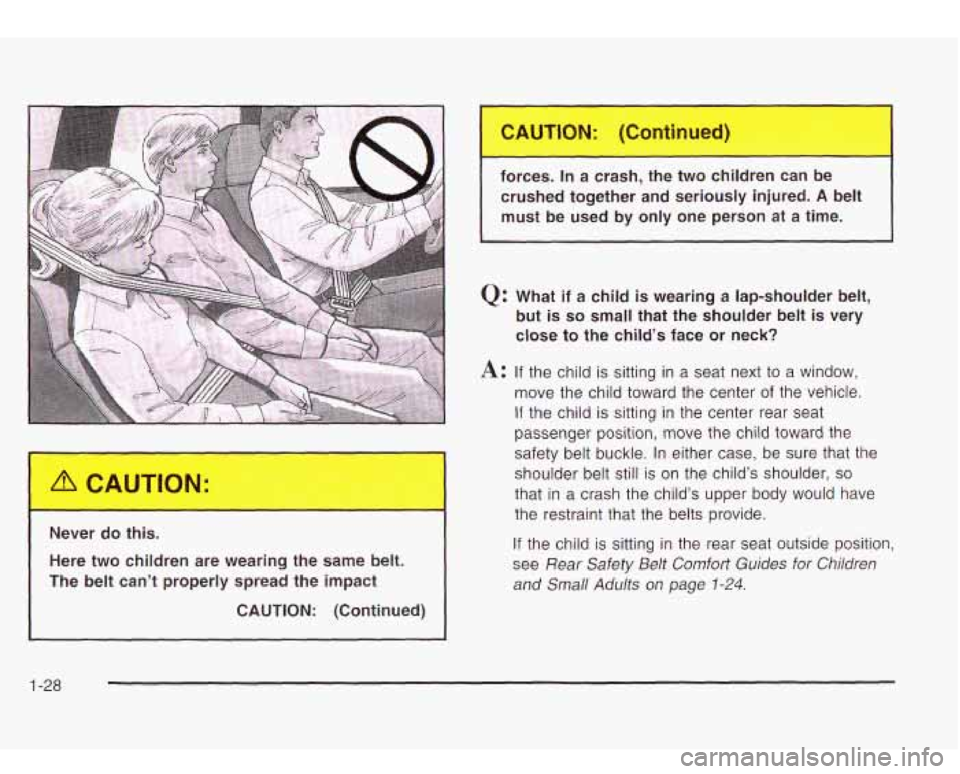
f ~ ~ :es 1 a crash, the two chi1 en can be
crushed together and seriously injured.
A belt
must be used by only one person at a time.
Q: What if a child is wearing a lap-shoulder belt,
but is so small that the shoulder belt is very
close to
the child’s face or neck?
S.
1 I
Here two children are wearing the same belt.
The belt can’t properly spread the impact
CAUTION: (Continued)
I I
A: If the child is sitting in a seat next to a window,
move the child toward the center
of the vehicle.
If the child is sitting in the center rear seat
passenger position, move the child toward the
safety belt buckle. In either case, be sure that the
shoulder belt still is on the child’s shoulder,
so
that in a crash the child’s upper body would have
the restraint that the belts provide.
If the child
is sitting in the rear seat outside position,
see
Rear Safety Belt Comfort Guides for Children
and Small Adults
on page 1-24.
1-28
Page 39 of 410
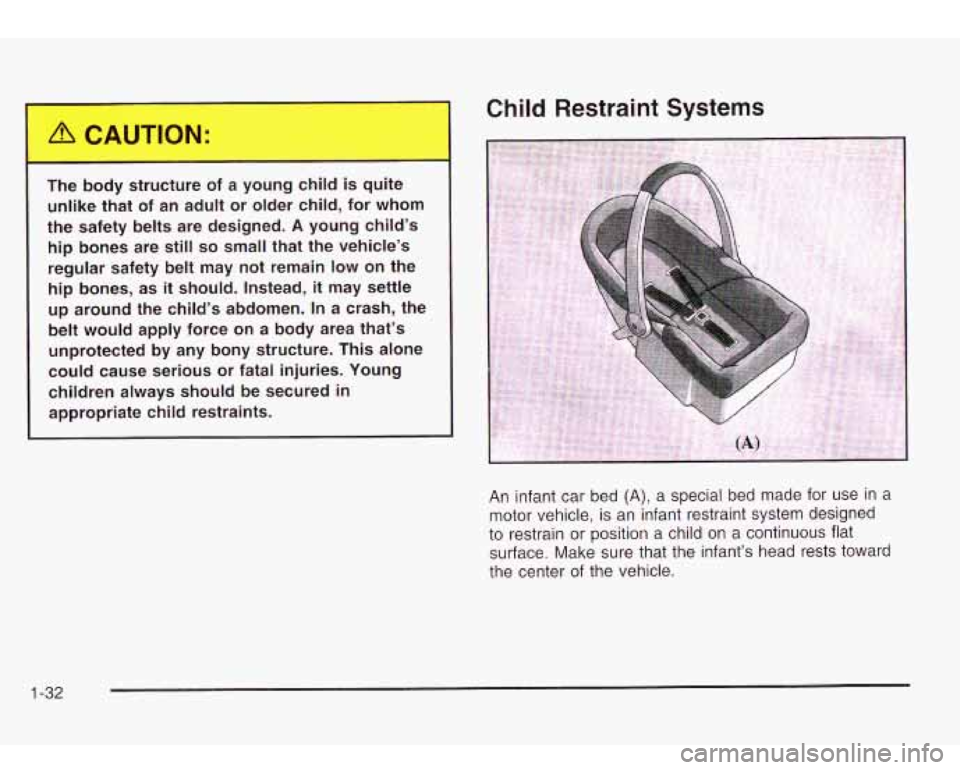
1
Child Restraint Systems
The body structure of a young child is quite
unlike that of an adult or older child, for whom
the safety belts are designed.
A young child’s
hip bones are still so small that the vehicle’s
regular safety belt may not remain low on the
hip bones,
as it should. Instead, it may settle
up around the child’s abdomen.
In a crash, the
belt would apply force on
a body area that’s
unprotected by any bony structure. This alone
could cause serious or fatal injuries. Young children always should be secured in
appropriate child restraints.
t
I
‘L
An infant car bed (A), a special bed made for use in a
motor vehicle, is an infant restraint system designed
to restrain or position a child
on a continuous flat
surface. Make sure that the infant’s head rests toward
the center of the vehicle.
1 -32
Page 59 of 410
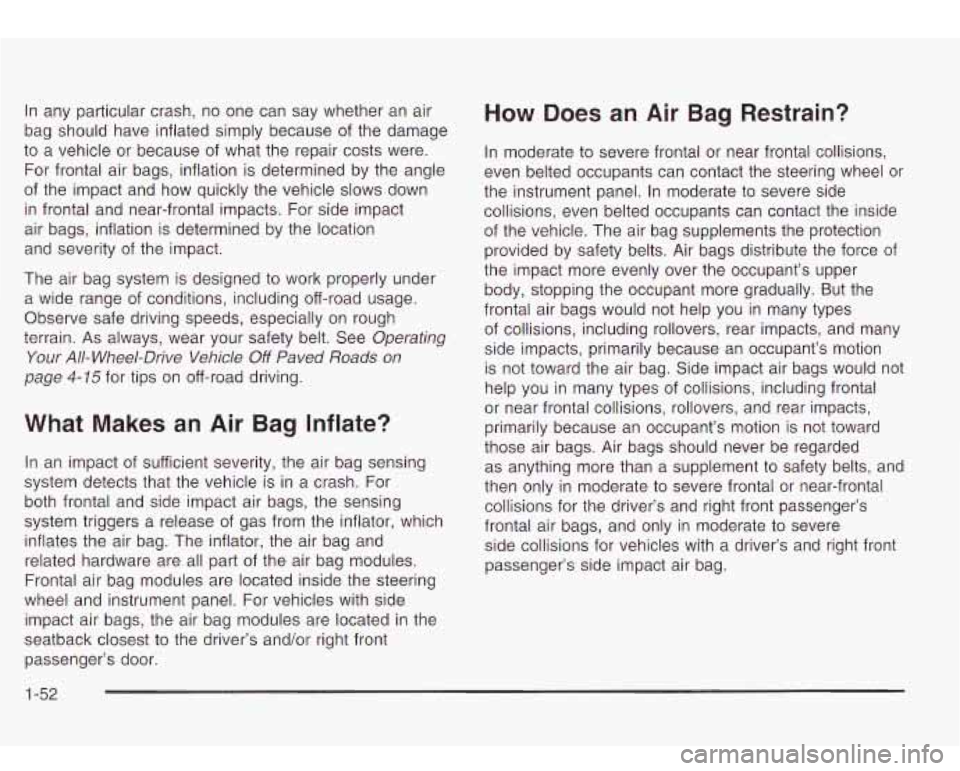
In any particular crash, no one can say whether an air
bag should have inflated simply because of the damage
to a vehicle or because of what the repair costs were.
For frontal air bags, inflation is determined by the angle
of the impact and how quickly the vehicle slows down
in frontal and near-frontal impacts. For side impact
air bags, inflation is determined by the location and severity of the impact.
The air bag system is designed
to work properly under
a wide range of conditions, including off-road usage.
Observe safe driving speeds, especially on rough
terrain. As always, wear your safety belt. See
Operating
Your All-Wheel-Drive Vehicle
Off Paved Roads on
page
4-15 for tips on off-road driving.
What Makes an Air Bag Inflate?
In an impact of sufficient severity, the air bag sensing
system detects that the vehicle is in a crash. For
both frontal and side impact air bags, the sensing
system triggers a release of gas from the inflator, which
inflates the air bag. The inflator, the air bag and
related hardware are all part of the air bag modules.
Frontal air bag modules are located inside the steering
wheel and instrument panel. For vehicles with side
impact air bags, the air bag modules are located in the
seatback closest
to the driver’s and/or right front
passenger’s door.
How Does an Air Bag Restrain?
In moderate to severe frontal or near frontal collisions,
even belted occupants can contact the steering wheel or
the instrument panel. In moderate
to severe side
collisions, even belted occupants can contact the inside
of the vehicle. The air bag supplements the protection
provided by safety belts. Air bags distribute the force of
the impact more evenly over the occupant’s upper
body, stopping the occupant more gradually. But the
frontal air bags would not help you in many types
of collisions, including rollovers, rear impacts, and many
side impacts, primarily because an occupant’s motion
is not toward the air bag. Side impact air bags would not
help you in many types of collisions, including frontal
or near frontal collisions, rollovers, and rear impacts,
primarily because an occupant’s motion is not toward
those air bags. Air bags should never be regarded
as anything more than a supplement
to safety belts, and
then only in moderate
to severe frontal or near-frontal
collisions for the driver’s and right front passenger’s
frontal air bags, and only in moderate
to severe
side collisions for vehicles with a driver’s and right front
passenger’s side impact air bag.
1-52
Page 75 of 410
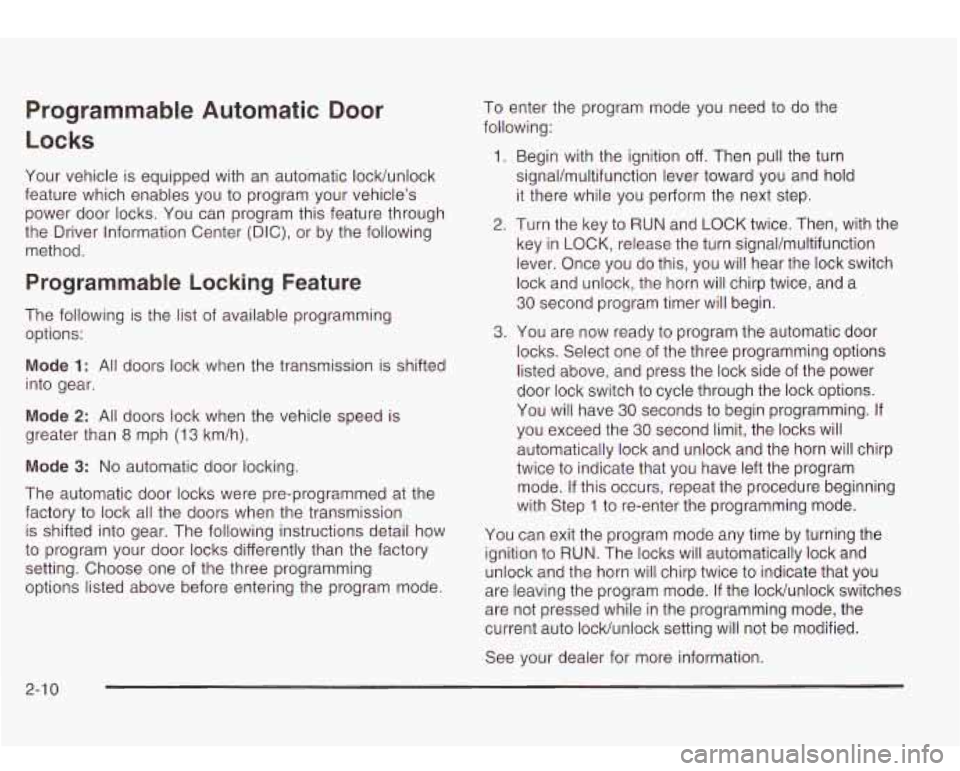
Programmable Automatic Door
Locks
Your vehicle is equipped with an automatic IocWunlock
feature which enables you
to program your vehicle’s
power door locks. You can program this feature through
the Driver Information Center (DIC), or by the following
method.
Programmable Locking Feature
The following is the list of available programming
options:
Mode 1: All doors lock when the transmission is shifted
into gear.
Mode
2: All doors lock when the vehicle speed is
greater than
8 mph (13 km/h).
Mode 3: No automatic door locking.
The automatic door locks were pre-programmed at the
factory to lock all the doors when the transmission
is shifted into gear. The following instructions detail how
to program your door locks differently than the factory
setting. Choose one of the three programming
options listed above before entering the program mode. To
enter the program mode you need to do the
following:
1.
2.
3.
Begin with the ignition off. Then pull the turn
signaVmultifunction lever toward you and hold
it there while you perform the next step.
Turn the key
to RUN and LOCK twice. Then, with the
key in LOCK, release the turn signaVmultifunction
lever. Once you do this, you will hear the lock switch
lock and unlock, the horn will chirp twice, and a
30 second program timer will begin.
You are now ready to program the automatic door
locks. Select one of the three programming options
listed above, and press the lock side of the power
door lock switch to cycle through the lock options.
You will have
30 seconds to begin programming. If
you exceed the
30 second limit, the locks will
automatically lock and unlock and the horn will chirp
twice
to indicate that you have left the program
mode. If this occurs, repeat the procedure beginning
with Step
1 to re-enter the programming mode.
You can exit the program mode any time by turning the
ignition
to RUN. The locks will automatically lock and
unlock and the horn will chirp twice
to indicate that you
are leaving the program mode. If the IocWunlock switches
are not pressed while in the programming mode, the
current auto IocWunlock setting will not be modified.
See your dealer for more information.
2-1 0
Page 76 of 410
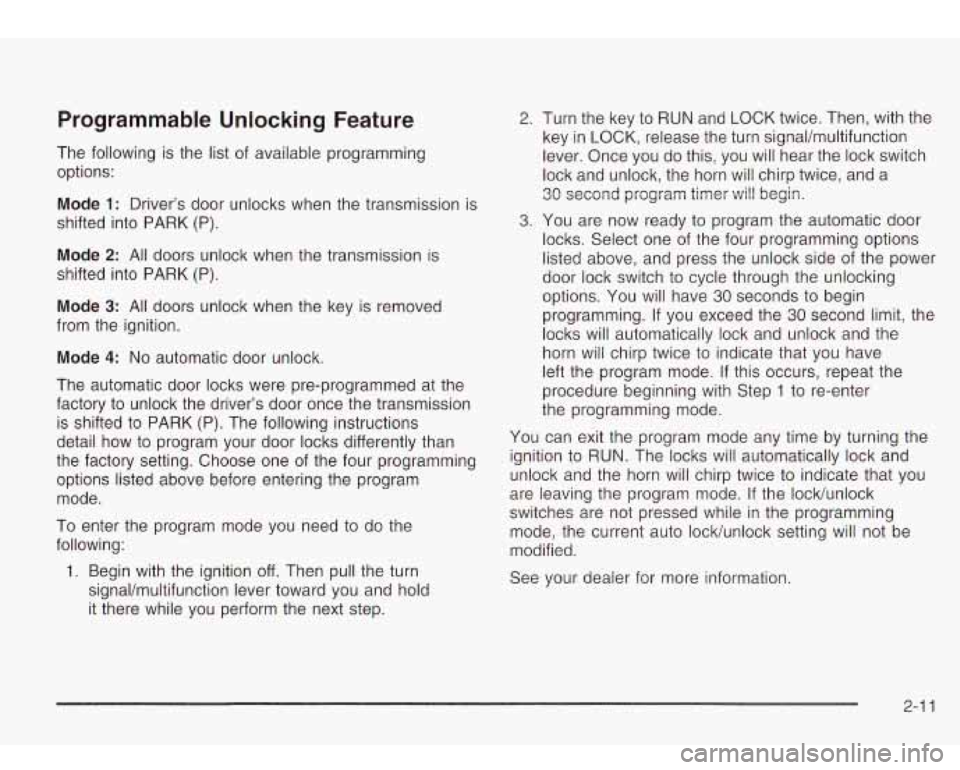
Programmable Unlocking Feature
The following is the list of available programming
options:
Mode 1: Driver’s door unlocks when the transmission is
shifted into PARK (P).
Mode 2: All doors unlock when the transmission is
shifted into PARK (P).
Mode 3: All doors unlock when the key is removed
from the ignition.
Mode 4: No automatic door unlock.
The automatic door locks were pre-programmed at the
factory to unlock the driver’s door once the transmission
is shifted
to PARK (P). The following instructions
detail how to program your door locks differently than
the factory setting. Choose one of the four programming
options listed above before entering the program
mode.
To enter the program mode you need
to do the
following:
1. Begin with the ignition off. Then pull the turn
signaVmultifunction lever toward you and hold
it there while you perform the next step.
2.
3.
Turn the key to RUN and LOCK twice. Then, with the
key in LOCK, release the turn signal/multifunction
lever. Once you do this, you will hear the lock switch
lock and unlock, the horn will chirp twice, and a
30 second program timer will begin
You are now ready
to program the automatic door
locks. Select one
of the four programming options
listed above, and press the unlock side of the power
door lock switch
to cycle through the unlocking
options. You will have
30 seconds to begin
programming. If you exceed the
30 second limit, the
locks will automatically lock and unlock and the
horn will chirp twice
to indicate that you have
left the program mode. If this occurs, repeat the
procedure beginning with Step
1 to re-enter
the programming mode.
You can exit the program mode any time by turning the
ignition to RUN. The locks will automatically lock and
unlock and the horn will chirp twice
to indicate that you
are leaving the program mode.
If the IocWunlock
switches are not pressed while in the programming
mode, the current auto IocWunlock setting will not be
modified.
See your dealer for more information.
2-1 1
Page 83 of 410
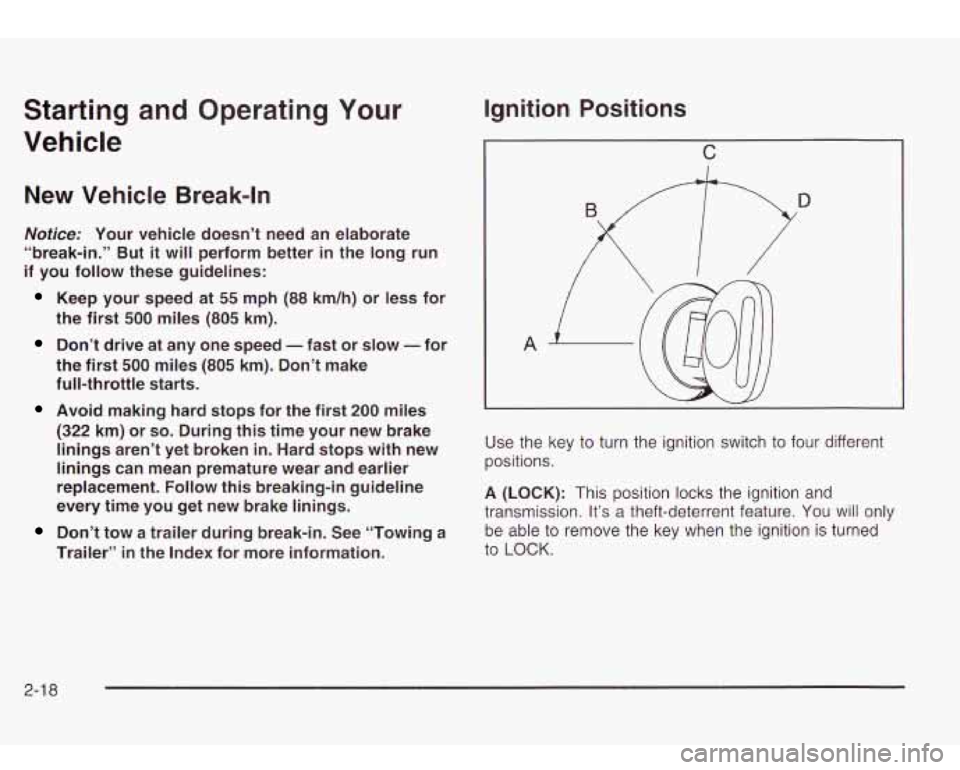
Starting and Operating Your
Vehicle
New Vehicle Break-In
Notice: Your vehicle doesn’t need an elaborate
“break-in.” But
it will perform better in the long run
if you follow these guidelines:
Keep your speed at 55 mph (88 km/h) or less for
the first
500 miles (805 km).
Don’t drive at any one speed -fast or slow
- for
the first
500 miles (805 km). Don’t make
full-throttle starts.
Avoid making hard stops for the first
200 miles
(322 km) or so. During this time your new brake
linings aren’t yet broken in. Hard stops with new
linings can mean premature wear and earlier
replacement. Follow
this breaking-in guideline
every time you get new brake linings.
Don’t tow a trailer during break-in. See “Towing a
Trailer” in the Index for more information.
Ignition Positions
C
Use the key to turn the ignition switch to four different
positions.
A (LOCK): This position locks the ignition and
transmission. It’s a theft-deterrent feature. You will only
be able to remove the key when the ignition is turned
to LOCK.
2-1 8
Page 87 of 410
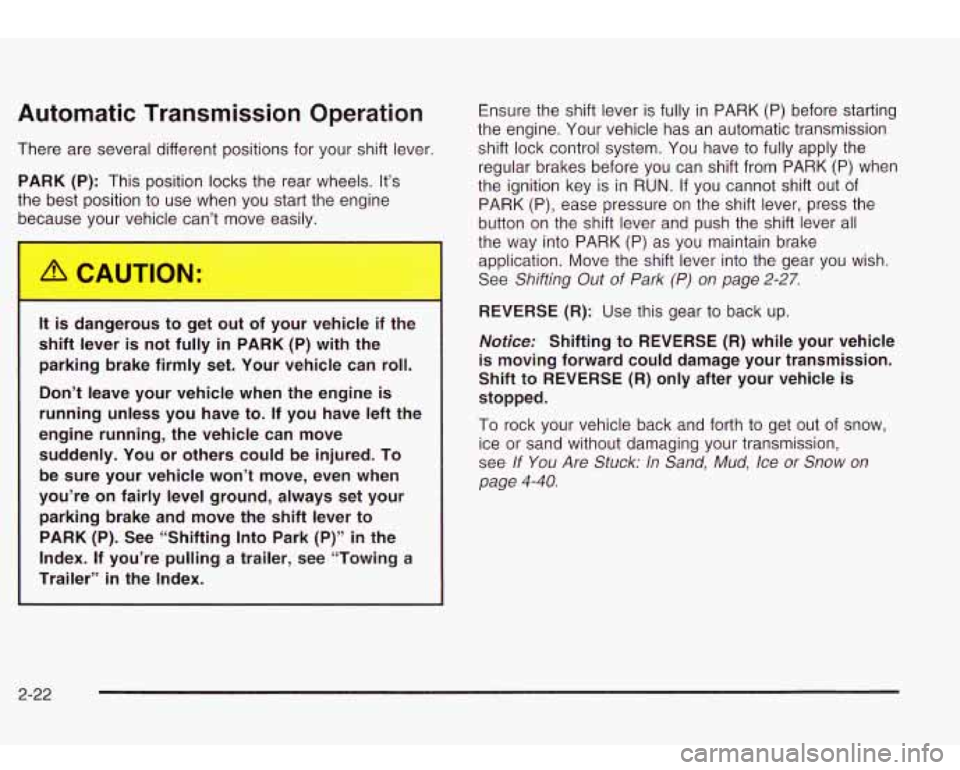
Automatic Transmission Operation
There are several different positions for your shift lever
PARK (P): This position locks the rear wheels. It’s
the best position to use when you start the engine because your vehicle can’t move easily.
It is dangerous to get out of your vehicle if the
shift lever
is not fully in PARK (P) with the
parking brake firmly set. Your vehicle can roll.
Don’t leave your vehicle when the engine
is
running unless you have to. If you have left the
engine running, the vehicle can move suddenly. You or others could be injured. To be sure your vehicle won’t move, even when
you’re on fairly level ground, always set your parking brake and move the shift lever to PARK (P). See “Shifting Into Park (P)”
in the
Index. If you’re pulling a trailer, see “Towing a
Trailer”
in the Index. Ensure
the shift lever is fully in PARK (P) before starting
the engine. Your vehicle has an automatic transmission
shift lock control system. You have to fully apply the
regular brakes before you can shift from PARK
(P) when
the ignition key is in RUN. If you cannot shift out of
PARK (P), ease pressure on the shift lever, press the
button on the shift lever and push the shift lever all
the way into PARK (P) as you maintain brake
application. Move the shift lever into the gear you wish.
See
Shifting Out of Park (P) on page 2-27.
REVERSE (R): Use this gear to back up.
Notice: Shifting to REVERSE (R) while your vehicle
is moving forward could damage your transmission.
Shift to
REVERSE (R) only after your vehicle is
stopped.
To rock your vehicle back and forth to get out of snow,
ice or sand without damaging your transmission,
see
If You Are Stuck: In Sand, Mud, Ice or Snow on
page
4-40.
2-22
Page 88 of 410
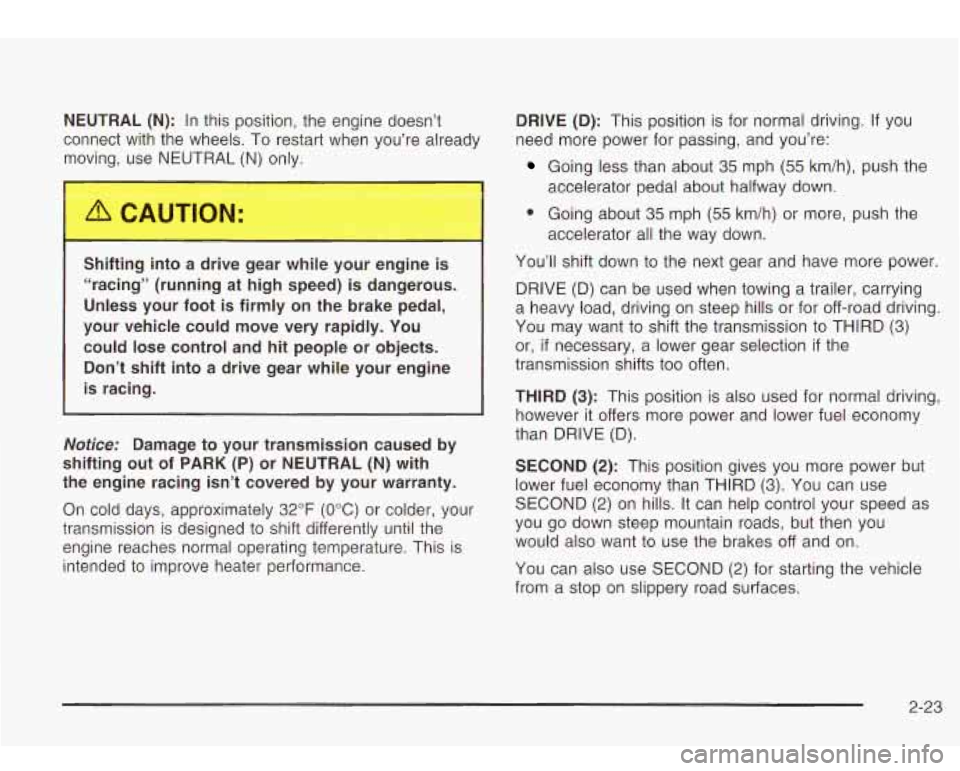
NEUTRAL (N): In this position, the engine doesn’t
connect with the wheels. To restart when you’re already
moving, use N ITRAL
(N) only.
1 ifting into c _. 2 gear w e your engine is
“racing” (running at high speed) is dangerous.
Unless your foot is firmly on the brake pedal,
your vehicle could move very rapidly. You
could lose control and hit people or objects.
Don’t shift into a drive gear while your engine
is racing.
Nofice: Damage to your transmission caused by
shifting out
of PARK (P) or NEUTRAL (N) with
the engine racing isn’t covered by your warranty.
On cold days, approximately 32°F (OOC) or colder, your
transmission is designed
to shift differently until the
engine reaches normal operating temperature. This is
intended
to improve heater performance.
DRIVE (D): This position is for normal driving. If you
need more power for passing, and you’re:
Going less than about 35 mph (55 km/h), push the
0 Going about 35 mph (55 km/h) or more, push the
You’ll shift down
to the next gear and have more power.
DRIVE (D) can be used when towing a trailer, carrying
a heavy load, driving on steep hills or for off-road driving.
You may want
to shift the transmission to THIRD (3)
or, if necessary, a lower gear selection if the
transmission shifts
too often.
accelerator pedal about halfway down.
accelerator all the way down.
THIRD (3): This position is also used for normal driving,
however it offers more power and lower fuel economy
than DRIVE (D).
SECOND (2): This position gives you more power but
lower fuel economy than THIRD (3). You can use
SECOND (2) on hills. It can help control your speed as
you go down steep mountain roads, but then you
would also want to use the brakes
off and on.
You can also use SECOND (2) for starting the vehicle
from a stop on slippery road surfaces.
2-23
Page 89 of 410
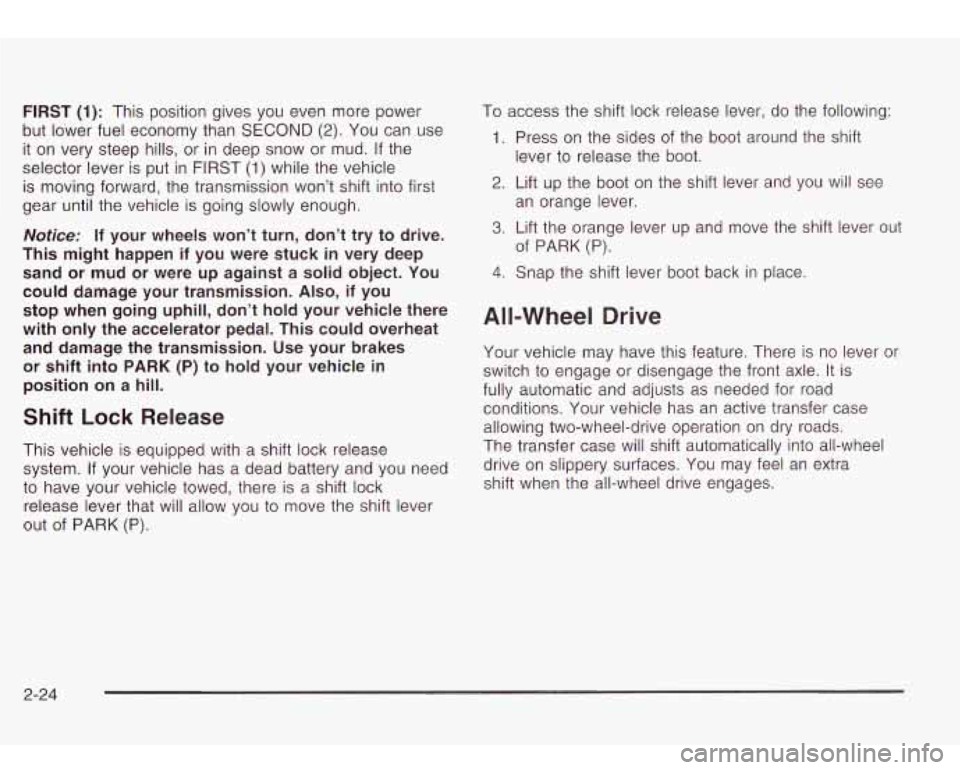
FIRST (1): This position gives you even more power
but lower fuel economy than
SECOND (2). You can use
it on very steep hills, or in deep snow or mud.
If the
selector lever is put in FIRST
(1) while the vehicle
is moving forward, the transmission won’t shift into first
gear until the vehicle is going slowly enough.
Notice: If your wheels won’t turn, don’t try to drive.
This might happen if you were stuck in very deep
sand or mud or were up against a solid object. You
could damage your transmission. Also, if you
stop when going uphill, don’t hold your vehicle there
with only the accelerator pedal. This could overheat
and damage the transmission. Use your brakes
or shift into
PARK (P) to hold your vehicle in
position on a hill.
Shift Lock Release
This vehicle is equipped with a shift lock release
system. If your vehicle has a dead battery and you need
to have your vehicle towed, there is a shift lock
release lever that will allow you to move the shift lever
out of PARK (P).
I o access the shift lock release lever, do the following:
1. Press on the sides of the boot around the shift
2. Lift up the boot on the shift lever and you will see
lever
to release the boot.
an orange lever.
3. Lift the orange lever up and move the shift lever out
of
PARK (P).
4. Snap the shift lever boot back in place.
All-Wheel Drive
Your vehicle may have this feature. There is no lever or
switch to engage
or disengage the front axle. It is
fully automatic and adjusts as needed for road
conditions. Your vehicle has an active transfer case
allowing two-wheel-drive operation on dry roads.
The transfer case will shift automatically into all-wheel
drive on slippery surfaces. You may feel an extra
shift when the all-wheel drive engages.
2-24
Page 90 of 410
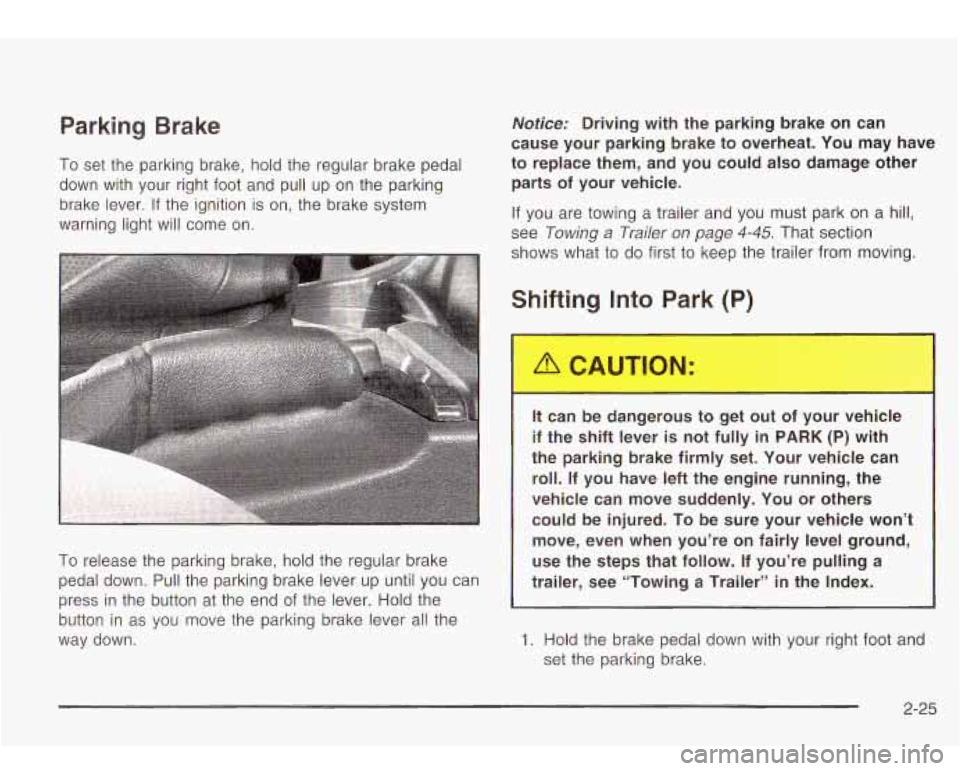
Parking Brake
To set the parking brake, hold the regular brake pedal
down with your right
foot and pull up on the parking
brake lever. If the ignition is on, the brake system
warning light will come on.
Notice: Driving with the parking brake on can
cause your parking brake to overheat. You may have
to replace them, and you could also damage other
parts of your vehicle.
If you are towing a trailer and
you must park on a hill,
see
Towing a Trailer on page 4-45. That section
shows what
to do first to keep the trailer from moving.
Shifting Into Park (P)
To release the parking brake, hold the regular brake
pedal down. Pull the parking brake lever up until you can
press in the button at the end
of the lever. Hold the
button in as you move the parking brake lever all the
way down.
It can be dangerous to get out of your vehicle
if the shift lever is not fully in
PARK (P) with
the parking brake firmly set. Your vehicle can
roll. If you have left the engine running, the
vehicle can move suddenly. You or others could be injured. To be sure your vehicle won’t
move, even when you’re on fairly level ground,
use the steps that follow.
If you’re pulling a
trailer, see “Towing a Trailer” in the Index.
1. Hold the brake pedal down with your right foot and
set the parking brake.
2-25